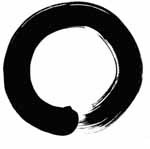22:
204:
To write Zen calligraphic characters that convey truly deep meaning, one must focus intensely and become one with the meaning of the characters they create. In order to do this, one must free one's mind and heart of disturbances and focus only on the meaning of the character. Becoming one with what
188:. However, the calligraphy of Zen scholars was often more concerned with spiritual qualities and individual expression and shunned technicalities which led to unique and distinctly personal styles. Japanese calligraphy has three basic styles: Kaisho 楷書, Gyōsho 行書, and Sōsho 草書, adopted from China.
196:
True creativity is not the product of consciousness but rather the "phenomenon of life itself." True creation must arise from mu-shin 無心, the state of "no-mind," in which thought, emotions, and expectations do not matter. Truly skillful Zen calligraphy is not the product of intense "practice;"
157:
Roshi as a way of Zen practice. Hitsuzendo is practised standing, using a large brush and ink, usually on newspaper roll. In this way, the whole body is used to guide the brush, in contrast to writing at a table.
77:
32:
142:
134:(well-proportioned and pleasing to the eye) is foreign. Instead, the calligraphy of Hitsuzendo must breathe with the vitality of eternal experience.
43:
321:
296:
274:
251:
61:
311:
316:
336:
123:), which is a unification with the highest reality. Hitsuzendo refers specifically to a school of
36:
that states a
Knowledge editor's personal feelings or presents an original argument about a topic.
331:
326:
264:
205:
you create, essentially, is the philosophy behind Zen
Calligraphy and other Japanese arts.
167:
8:
39:
292:
270:
247:
149:(1836–1888), founded the Hitsuzendo line of thought as a "practice to uncover one's
197:
rather, it is best achieved as the product of the "no-mind" state, a high level of
341:
146:
305:
176:王羲之 (Jp: Ou Gishi; 303-361) have had a profound influence, especially on the
150:
198:
112:
154:
131:
172:
Calligraphy was brought to Japan from China and
Chinese masters such as
173:
116:
185:
76:
222:
81:
290:
Zen
Brushwork - Focusing The Mind With Calligraphy And Painting
180:
style which is still practiced today. The indigenous
Japanese
215:
124:
33:
personal reflection, personal essay, or argumentative essay
127:
184:(和様書道, wayō-shodō) only appeared towards the end of the
153:
through the brush." This was then further developed by
130:calligraphy to which the rating system of modern
303:
246:, Weatherhill/Heibonsha, New York/Tojyo, 1973.
102:
96:
266:An Introduction to Japanese Kanji Calligraphy
191:
263:Kunii, Takezaki; Godin, Bob (2013-01-29).
262:
145:(1885–1966), inspired by the teachings of
62:Learn how and when to remove this message
236:
75:
304:
201:, and a heart free of disturbances.
15:
322:Zen Buddhist philosophical concepts
13:
14:
353:
269:. Tuttle Publishing. p. 8.
20:
244:The Art of Japanese Calligraphy
256:
1:
229:
115:to be a method of achieving
7:
208:
103:
10:
358:
165:
161:
137:
104:"way of Zen through brush"
97:
192:Philosophical background
312:East Asian calligraphy
86:
42:by rewriting it in an
79:
317:Japanese calligraphy
168:Japanese calligraphy
337:Zen art and culture
288:Terayama, Tanchu.
87:
44:encyclopedic style
31:is written like a
72:
71:
64:
349:
281:
280:
260:
254:
242:Nakata, Yujiro.
240:
110:
109:
106:
100:
99:
85:, the Zen circle
67:
60:
56:
53:
47:
24:
23:
16:
357:
356:
352:
351:
350:
348:
347:
346:
302:
301:
285:
284:
277:
261:
257:
241:
237:
232:
211:
194:
170:
164:
143:Yokoyama Tenkei
140:
111:is believed by
107:
94:
68:
57:
51:
48:
40:help improve it
37:
25:
21:
12:
11:
5:
355:
345:
344:
339:
334:
329:
324:
319:
314:
300:
299:
283:
282:
275:
255:
234:
233:
231:
228:
227:
226:
219:
210:
207:
193:
190:
182:wayō tradition
166:Main article:
163:
160:
147:Yamaoka Tesshu
139:
136:
119:(Japanese: 三昧
70:
69:
28:
26:
19:
9:
6:
4:
3:
2:
354:
343:
340:
338:
335:
333:
332:Visual motifs
330:
328:
325:
323:
320:
318:
315:
313:
310:
309:
307:
298:
297:4-7700-2944-6
294:
291:
287:
286:
278:
276:9781462905928
272:
268:
267:
259:
253:
252:0-8348-1013-1
249:
245:
239:
235:
225:
224:
220:
218:
217:
213:
212:
206:
202:
200:
189:
187:
183:
179:
175:
169:
159:
156:
152:
151:original self
148:
144:
135:
133:
129:
126:
122:
118:
114:
113:Zen Buddhists
105:
93:
92:
84:
83:
78:
74:
66:
63:
55:
45:
41:
35:
34:
29:This article
27:
18:
17:
327:Japanese art
289:
265:
258:
243:
238:
221:
214:
203:
199:spirituality
195:
181:
177:
171:
141:
120:
90:
89:
88:
80:
73:
58:
49:
30:
155:Omori Sogen
132:calligraphy
306:Categories
230:References
174:Wang Xizhi
91:Hitsuzendō
52:April 2010
186:Heian era
223:Bokuseki
209:See also
125:Japanese
162:History
138:Origins
117:samādhi
38:Please
295:
273:
250:
178:karayō
121:sanmai
342:Zenga
216:Zenga
293:ISBN
271:ISBN
248:ISBN
82:Ensō
128:Zen
98:筆禅道
308::
101:,
279:.
108:)
95:(
65:)
59:(
54:)
50:(
46:.
Text is available under the Creative Commons Attribution-ShareAlike License. Additional terms may apply.
